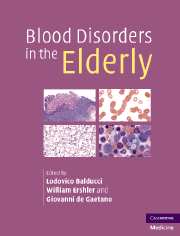Book contents
- Frontmatter
- Contents
- List of contributors
- Preface
- Part I Epidemiology
- Part II Hematopoiesis
- Part III Anemia of aging
- Part IV Hematologic malignancies and aging
- 18 Cancer chemotherapy in the older person
- 19 Acute myeloid leukemia in the elderly
- 20 Acute lymphoblastic leukemia in the elderly patient: diagnosis and therapy
- 21 Multiple myeloma
- 22 Non-Hodgkin lymphoma
- 23 Unusual lymphomas in the elderly
- 24 Chronic lymphocytic leukemia in the elderly
- 25 Polycythemia vera and idiopathic myelofibrosis in the elderly
- Part V Disorders of hemostasis in the elderly
- Index
18 - Cancer chemotherapy in the older person
from Part IV - Hematologic malignancies and aging
Published online by Cambridge University Press: 21 October 2009
- Frontmatter
- Contents
- List of contributors
- Preface
- Part I Epidemiology
- Part II Hematopoiesis
- Part III Anemia of aging
- Part IV Hematologic malignancies and aging
- 18 Cancer chemotherapy in the older person
- 19 Acute myeloid leukemia in the elderly
- 20 Acute lymphoblastic leukemia in the elderly patient: diagnosis and therapy
- 21 Multiple myeloma
- 22 Non-Hodgkin lymphoma
- 23 Unusual lymphomas in the elderly
- 24 Chronic lymphocytic leukemia in the elderly
- 25 Polycythemia vera and idiopathic myelofibrosis in the elderly
- Part V Disorders of hemostasis in the elderly
- Index
Summary
Introduction
The incidence and prevalence of cancer increases with age. In the year 2000, more than 50% of all malignancies occurred in the 12% of the population aged 65 and older. In the year 2030, the older population will account for 20% of the whole population and for 70% of all cancers. The number of older individuals receiving cytotoxic chemotherapy is progressively increasing, and it is legitimate to ask whether age may influence efficacy and toxicity of chemotherapy, especially the incidence of myelosuppression, which is the most common complication. In this chapter we will review the pharmacology of cytotoxic chemotherapy in the older aged person and explore methods to ameliorate the risk of toxicity.
Pharmacologic changes of aging
Pharmacokinetics
Most pharmacokinetic parameters may be influenced by age (Fig. 18.1). The absorption of nutrients decreases progressively due to reduced splanchnic circulation and absorbing surface, and reduced gastric motility and secretions. It is not clear whether bioavailability and efficacy of oral drugs may also be compromised. This is a practical issue as more oral cytotoxic agents are emerging. Oral agents are particularly suitable for the management of the older aged person, as they may be administered at home, and the dose may be adjusted on a daily basis.
- Type
- Chapter
- Information
- Blood Disorders in the Elderly , pp. 225 - 236Publisher: Cambridge University PressPrint publication year: 2007

